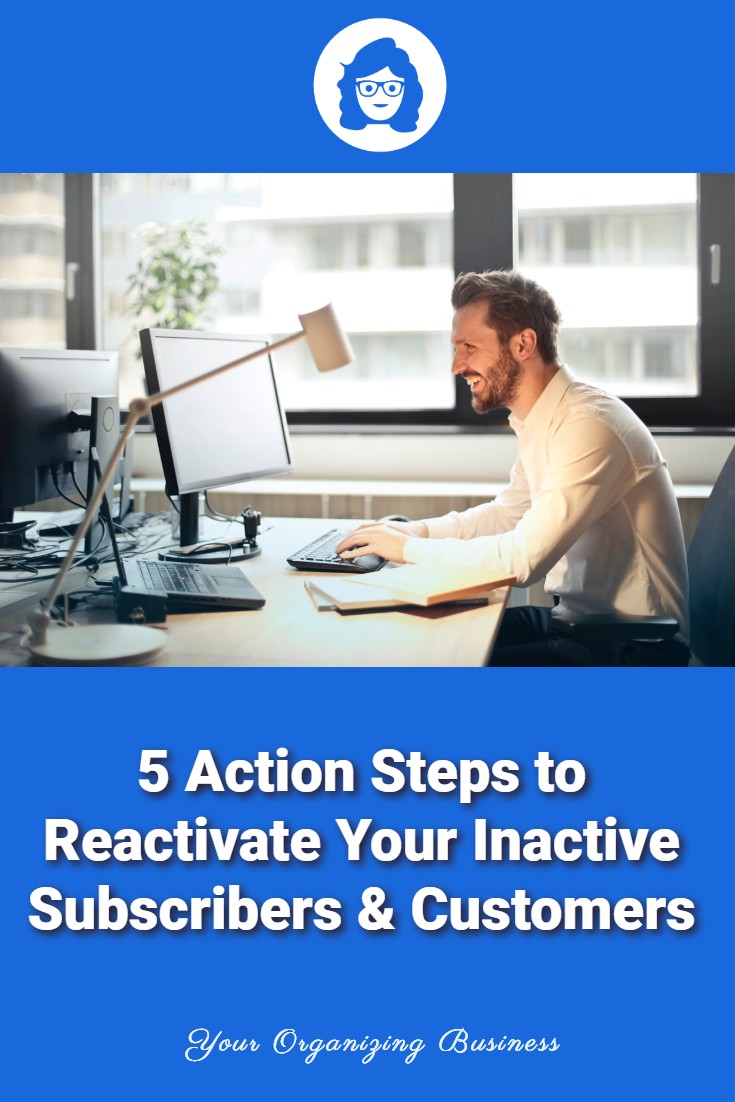5 Action Steps to Reactivate Your Inactive Subscribers & Customers
This page may contain links to Amazon.com or other sites from which I may receive commission on purchases you make after clicking on such links. Read my full Disclosure Policy

Engaged subscribers are an asset to every marketer and business owner. They click your links, read your content, and take action. Having more engaged subscribers in your contact list gives inspiration. It is also a good indication that your marketing campaign is progressing fine.
But then, not all active subscribers in your email list will remain active. After six months or even less, some of them will likely become inactive or opt-out of your email list.
The best way to handle inactive subscribers is not to remove them from your contact permanently. A wise approach is to launch a re-engagement campaign to win them back. And here are five action steps you can deploy to reactivate your inactive subscribers. Read on!
1. Know your inactive customers or subscribers
Your first approach is to identify those who are not responding to your email messages. You can identify them by the length of time they have been inactive. And the two factors that can help you identify them based on the period of inactivity are:
- Your send frequency – How often do you send out emails?
- The type of business (products or services) that you offer.
These two factors will help you identify your inactive customers or subscribers quickly. For instance, if your product has a shorter sales cycle, then inactive subscribers would be those who haven’t opened your last five email campaigns. If your marketing is seasonal, then it will take close to a year or more for any subscriber on your list to be tagged inactive.
2. Segment your inactive subscribers into groups
Your re-engagement campaign needs to target the right persons. So once you identify your inactive subscribers, divide them into various segments. One segment might contain those who haven’t clicked any of your links since they signed up. Another can have subscribers who were once active but are no longer responding.
You can also have a segment for inactive subscribers based on purchasing habits or for any data you feel is vital to your re-engagement campaign.
3. Pick a powerful subject line
You need to come up with a subject line that will convince your contacts to click on your link. Remember you are dealing with people who have little to no interest in your product or service. So you must work hard to create a captivating headline that will create that urgency in them to click and read your content.
One easy step to build a compelling subject line is to write at least two or more subject lines for the same content. Then use the CoSchedule Headline Analyzer to check the score for each headline. You can make use of the headline that has the highest score.
4. Build your content
At this stage, you already know your inactive subscribers and placed them in different segments. Bravo! Your next step would be to create top-notch content that will awaken their interests.
Again, content drafted for inactive subscribers who haven’t clicked any of your campaigns will be different from those who were once active. Keep that in mind when writing your content.
Below are tips to help you write killer content.
- Make it concise and straightforward. No time for fluff or beating around the bush.
- Edit your content ruthlessly to eliminate errors.
- Use a compelling CTA (Call to action).
- Make your readers believe you need them.
If you are not a good content writer, you can hire a freelancer or set up a remote team to help with this task. Let them handle the content-writing aspect while you do the sending since you have a better idea of your subscribers.
5. Introduce some incentives
You can’t catch a fish without bait. Same goes for your inactive subscribers. If you want most of them to click, read your content, and take action, offer something that will be difficult for them to turn down. But then, you should never make promises you cannot fulfill. Your incentives should also be of great value to your subscribers.
Below are incentives you can use to lure your inactive subscribers:
- Coupon
- Promo code
- Free eBooks
- Online contest
You can also use online surveys or polls to attract your subscribers. Ask them to complete a survey or poll to win a gift. You can offer free eBook, promo code, or bonus as the gift. Data from the surveys or polls can also enable you to understand your inactive subscribers better and take the right steps to win them back.
Photo by Bruce Mars from Pexels





Interesting idea to create two subject lines and then comparing them. I know I can do better on this. The challenge for me personally is that I like fun headlines, not necessarily the titles that will respond well to a Google search. I haven’t given much thought to inactive subscribers, so good tip!
I’ve never done it either. It would also be interesting to send a message to your whole list with Subject Line A, then a few days later send the same message to everyone who didn’t open the first one with Subject Line B and see what happens. You could repeat this as many times as would be worthwhile, using a different subject line for each. This might be a good approach for big announcements such as the launch of a new product or service, possibly overkill on a regular newsletter. It would also help to identify people who are probably never going to open your emails.
I learned about using CoSchedule Headline Analyzer from you some years back. Up until then, I’d been using a different headline analyzer. I can’t remember which one. But I like the way that CoSchedule addresses various elements of the title to help craft me craft a more effective one. I’ve never tried doing this type of analysis on my mailing list. I’m sure I could improve my results by testing and a better understanding of the metrics. I spend more of my time generating and sharing content, and less on the analytics. Maybe that’s a strategic error.
Looking at analytics lets you know whether your content marketing activities are bearing fruit. That said, it’s honestly not something I do on a regular basis. I know who is commenting on and sharing my posts, and I know where my referrals are coming from, so that tells me a lot.
I ran a re-engagement campaign within the past year or two, but I haven’t really studied the results, so I might be missing out on an opportunity. Seeing how many subscribers I re-engaged could help me decide whether and when to do another one.
Great suggestions! I created segments and it has helped me organize the audience better. I allow them to choose from 3 topics so when I email them, they are getting only the emails they want.
I wish more people would do that!
Gonna give this a try. Something that has been on the back burner because I felt clueless. Thank you!
Let us know how you make out!
Thank you for sharing these great tips!
Great information Janet. I have recently migrated to MailChimp and just completed the exercise of reviewing my lists and moving people into other lists. Reviewing my lists is something I need to do more often, so the right emails get to the right people.
It seems like extra work, but it makes the work you do to send out the emails worthwhile!